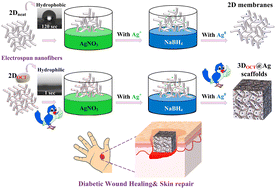A facile one-stone-two-birds strategy for fabricating multifunctional 3D nanofibrous scaffolds
Abstract
Local bacterial infections lead to delayed wound healing and in extreme cases, such as diabetic foot ulcers, to non-healing due to the impaired cellular function in such wounds. Thus, many scientists have focused on developing advanced therapeutic platforms to treat infections and promote cellular proliferation and angiogenesis. This study presents a facile approach for designing nanofibrous scaffolds in three dimensions (3D) with enhanced antibacterial activity to meet the need of treating chronic diabetic wounds. Being a cationic surfactant as well as an antimicrobial agent, octenidine (OCT) makes a 2D membrane hydrophilic, enabling it to be modified into a 3D scaffold in a “one stone, two birds” manner. Aqueous sodium borohydride (NaBH4) solution plays a dual role in the fabrication process, functioning as both a reducing agent for the in situ synthesis of silver nanoparticles (Ag NPs) anchored on the nanofiber surface and a hydrogen gas producer for expanding the 2D membranes into fully formed 3D nanofiber scaffolds, as demonstrated by morphological analyses. Various techniques were used to characterize the developed scaffold (e.g., SEM, XRD, DSC, FTIR, and surface wettability), demonstrating a multilayered porous structure and superhydrophilic properties besides showing sustained and prolonged release of OCT (61% ± 1.97 in 144 h). Thanks to the synergistic effect of OCT and Ag NPs, the antibacterial performance of the 3D scaffold was significantly higher than that of the 2D membrane. Moreover, cell viability was studied in vitro on mouse fibroblasts L929, and the noncytotoxic character of the 3D scaffold was confirmed. Overall, it is shown that the obtained multifunctional 3D scaffold is an excellent candidate for diabetic wound healing and skin repair.



 Please wait while we load your content...
Please wait while we load your content...